“You can’t connect the dots looking forward; you can only connect them looking backward.” This quote from Steve Jobs is applicable to many scenarios in business—one of which being customer insights.
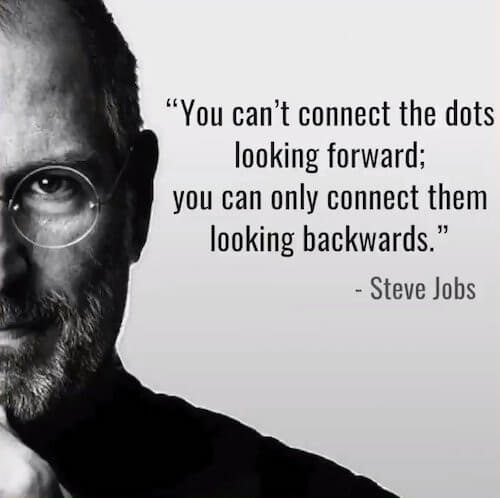
Using historical data to collect customer insights is a must for any business that wants to attract and retain customers and stand apart from competitors. In this post, we’re going to cover:
- What customer insights are and why they’re important.
- 10 ways to collect customer insights
- Over 30 ways to apply them for marketing and growth.
What are customer insights?
Customer insights are the interpretations and patterns of all the data you collect on your customers across all of your touch points. Some are directly obtained, such as through customer feedback and form fills, while others are inferred, such as through website analytics or loyalty program behavior.
There are countless quantitative and qualitative metrics behind customer insights, and which ones are important depend on your business and audience. However, research by GetApp found 16% of teams have the right amount of data, but not the right insights.
The importance of customer insights in marketing
Customer insights are necessary for forming buyer personas—fictional characters that represent your ideal customers—who they are, their demographics, what their pain points are, what impresses them and what disappoints them, what products/services they buy often, what influences their purchasing decisions, and the list goes on.
The more you understand about your audience, the better you can:
- Deliver the right message at the right time.
- Showcase the right product at the right price point.
- Highlight the exact features that customers are looking for.
- Develop empathy and emotional connection.
- Strengthen your unique selling proposition.
- Segment, target, and personalize your campaigns.
This, in turn will keep customer satisfaction high, reduce churn, increase loyalty, and more—all of which are part of an effective growth marketing strategy.
How and where to gather customer insights
Collecting customer insights might feel like searching for a needle in a haystack, but if you know where and how to look for it, you can separate the signal from the noise. Here are 10 such sources along with tips on how to use them.
1. Online reviews
Online reviews are the most authentic source to know how your customers feel about your products and services. Use them to identify what customers perceive your brand to be doing well, what needs improvement, and what they find better in competition.
This includes your reviews on Google, Facebook, Yelp, the Better Business Bureau, Glassdoor, and other niche directories. For software or SaaS, some of the popular ones include G2, Capterra, Clutch, Trustpilot, and TrustRadius.
These require the reviewer to create an account using their social credentials like Facebook, Google, or LinkedIn, so we can take comfort in the fact that these reviews are genuine.
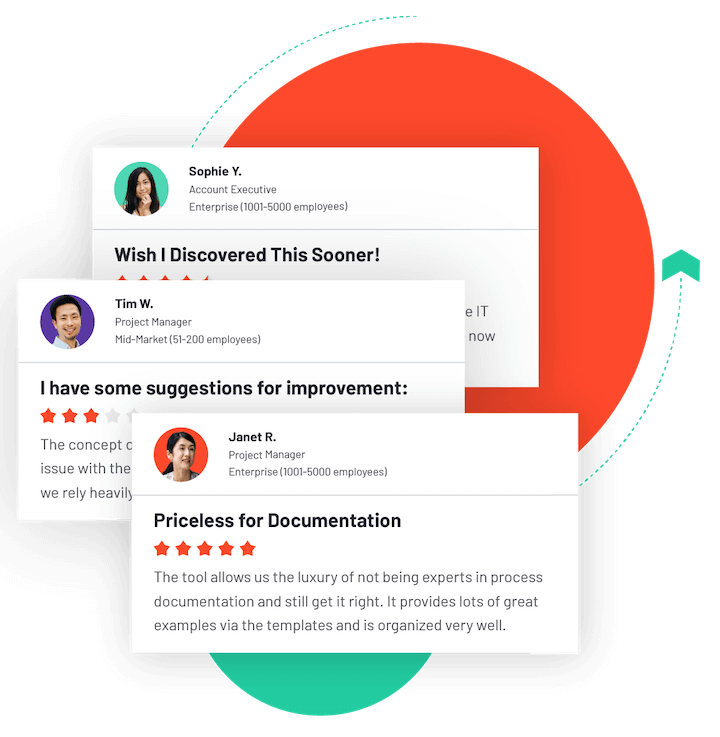
How to use customer insights from online reviews:
- Learn the little things that stand out to customers and harness those in your customer service.
- Stay on top of complaints and product/service shortcomings.
- Understand the terms your customers use to describe their problems and needs and incorporate those into your copywriting.
2. Competitor’s reviews
Similarly, you can also gather insights about your audience from competitors’ reviews. You can find these on the same sights above as well as groups on social media channels where there may be online communities for those product users.
Scott Chow, a B2B consultant and founder of The Blog Starter, says “You can dive deeper into customer reviews to get a handle on what expectations customers had when they signed up for competitor offerings and what they actually got. Look out for gaps that your product can fill. Incorporate the learnings into your product messaging and positioning. Ultimately, all this is going to generate more leads since your offerings will perfectly match customer expectations.”
How to use customer insights from competitor reviews:
- Identify their shortcomings and position yourself accordingly.
- Find out what strengths they have that you don’t (find our SWOT analysis template here!).
- Get ideas for features or gestures that resonate well with your audience.
3. Website data
With Google Analytics and Search Console, you can gather a wealth of insights about your customers, including:
- Behavioral data: what keywords they were searching when they found your site, what paths they’re taking on your site, which pages they’re exiting on, what content they’re most interested in, and more.
- Demographic data: age, gender location, interests, devices, and more.
- Campaign data: which pages are driving leads and sales, paths to purchase, and more.
This is why it’s essential to have a website and for all of your marketing campaigns to lead back to your website.
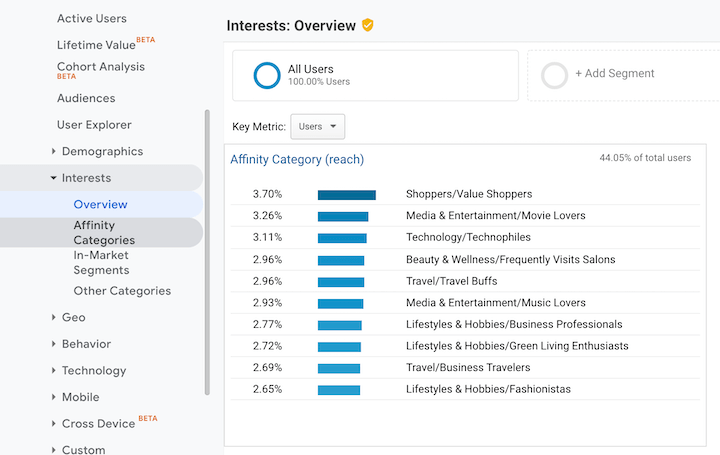
Affinity Categories is just one of the insights you can gather about your website visitors using Google Analytics.
How to use customer insights from website data:
- Identify keywords and topics to target with your content.
- Find out which pages they’re exiting on that may need an exit popup or call to action.
- See what landing page copy drives more conversions.
- Identify which channels generate the most success and allocate resources accordingly.
4. Competitor website data
You of course can’t get as much detailed information from a competitor’s website, but SEO tools like Semrush and Ahrefs can give you plenty to work with. For example, if you’re a design agency and Venngage is a competitor, Ahrefs will show you the keywords they’re targeting with their content and ads. 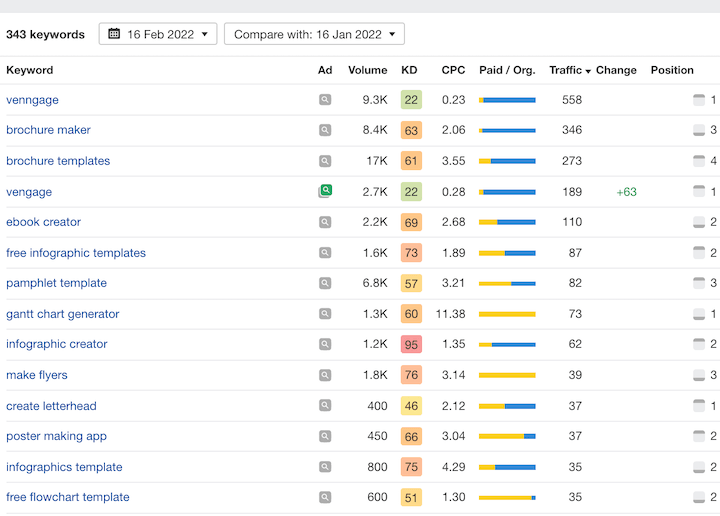
In the above results, we can see that clearly, Venngage customers like templates. This may be something you want to add to your offerings or adjust your positioning around.
How to use customer insights from competitor website data:
- Identify a strategic product messaging and positioning in your market.
- Get ideas for keywords to target—paid and organic.
- Find potential domains to target for link-building.
5. Preferences & purchase activity
Your customers’ purchasing patterns give you direct visibility into which products and services are most popular—both in general and among individuals. You can get this information if you track purchases in your CRM or if you have an ecommerce platform. In addition, if you have an email list or any other platform that requires an account, you can create preference centers to capture even more direct insights.
These direct insights (known as zero and first-party data) are becoming more and more crucial as third-party cookies get closer to their end.
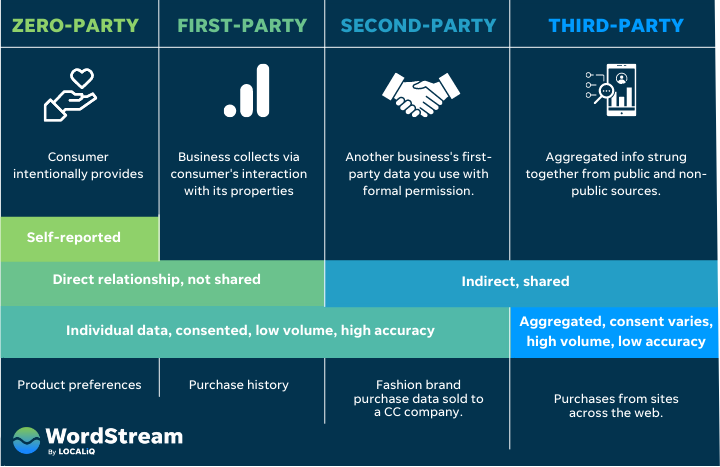
How to use customer insights from preferences and purchase activity:
- Identify seasonal patterns and stock accordingly (A must, according to our marketing trends list).
- Personalize communications and marketing campaigns.
- Identify products and services to build on.
6. Customer surveys
Surveys have been used by businesses since the days of door-to-door marketing, but today we have online survey tools to share surveys through email, social media, in apps, and more. Surveys can be point-based, multiple choice, open-ended or any combination. It’s best to segment out your survey campaigns into specific cohorts so you can customize your questions—like new customers, loyal customers, your top referrers, or even disengaged ones.
Some good questions to ask in your survey include:
- How did you find out about us?
- What did you like the most?
- Ease of ordering
- Customer service
- Pricing
- Packaging
- Other reasons
- What do you think we should improve?
Another option is the one-question Net Promoter Score (NPS) survey:
“On a scale of 0 to 10, how likely are you to recommend our business to a friend or colleague?”
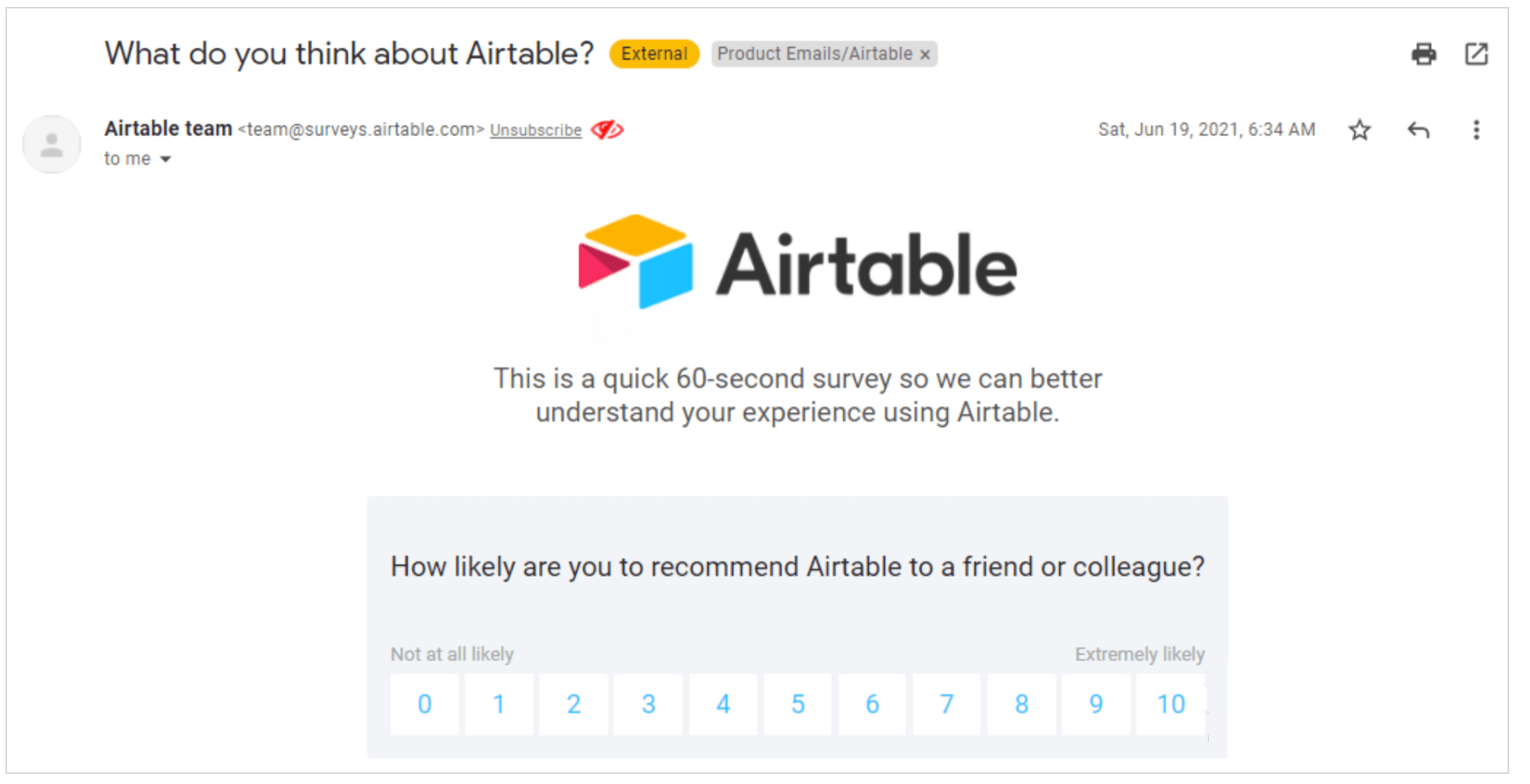
How to use customer insights from surveys:
- Understand the general sentiment toward your business.
- Identify strengths to harness and weaknesses to improve.
- Find out if starting a referral program would be worth your investment.
7. Customer interviews
Compared to customer surveys which are sent in a bulk fashion to several customers, customer interviews are done in a one-to-one fashion. They can be done in person, on the phone, or in a video call.
These allow you to get more elaborate answers that customers may not make the effort to write as a survey response. You can discuss things like:
- How did you come to know about us?
- What made you choose us over other alternatives?
- What feature does your business use the most?
- What do you think could make our product even better?
Assaf Cohen, who runs gaming studio Solitaire Bliss explains, “Customer interviews allow you to dig deeper on the fly and gain deeper insights, something you can’t do with surveys. For instance, when trying to learn what games to build next through customer interviews, we discovered multiplayer games have a special appeal due to their social nature.”
Ways to use customer interviews
- Identify nuances and micromoments you can improve.
- Build your relationship with customers.
- Get ideas for new features or offerings to add to the roadmap.
8. Success stories and case studies
Success stories, testimonials, and case studies are another form of customer interview. But whereas the above focuses on customer feedback, this one is about the story of how they used your business to solve their problem. These are public-facing materials written, video, or audio form.
Here are the typical questions a success story seeks to answer:
- What problem were you facing? What were the consequences?
- How did you find us and why did you choose us?
- What product or service did you use to solve your problem?
- What were the results and benefits?
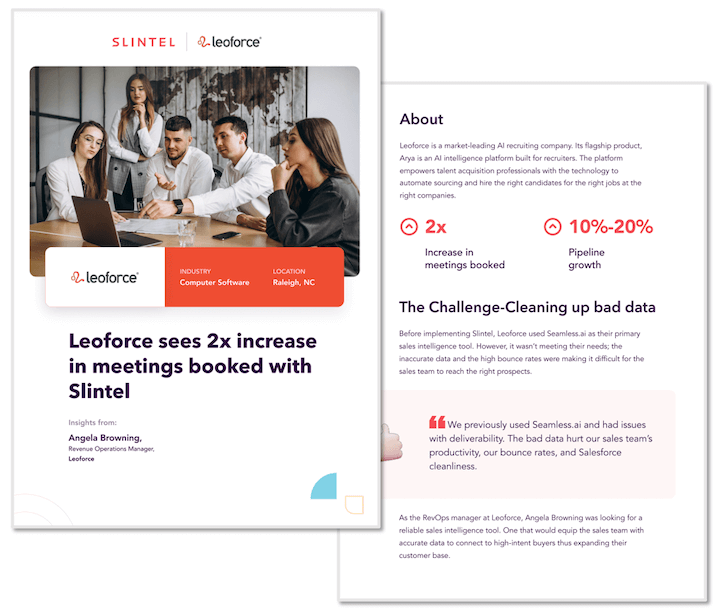
How to use customer insights from success stories:
- Provide during discovery calls and sales pitches.
- Post them on your website for visitors to browse.
- Create and sell persona-specific use cases.
9. Partnerships
The digital economy has become a web where most products and services can’t exist on their own. It’s necessary to shake hands, or in tech terms, integrate seamlessly, with other services and applications.
For example, a SaaS payment solution might want to partner up with invoicing, proposal, accounting, and sales software. Not only can you increase the appeal of your product, but you can share insights with one another.
How to use customer insights from partnerships:
- Find creative promotions and giveaways to run.
- Discover adjacent topics to cover in your blog posts.
- Get ideas for add-ons and features.
10. Social media
People don’t hold back from showering praise or complaints on social media, making it a great place to gather customer insights. You can monitor comments and posts to keep an ear out, but you can also openly ask for feedback through posts and polls (you can learn how to gather intel using Instagram Story polls here).

Your social media analytics are also a treasure trove of customer insights. Just remember, your social audience may be slightly different from your actual customer audience.
How to use customer insights from social media:
- Get a feel for the language your customers use.
- Understand their perspectives on an emotional level.
- Find out product preferences and interests.
Collect & apply customer insights
Customer insights remove the signal from the noise and help you focus on the channels, positioning, offerings, and messaging worth your time and money. But they’re not available in a single file from a sole destination. You have to gather them through multiple sources, and thanks to digital marketing, you now have the tools to do it! To recap, here are the ten ways to gather customer insights:
- Online reviews
- Competitor reviews
- Website data
- Competitor website data
- Polls and surveys
- Preference and purchase activity
- Customer interviews
- Case studies
- Partnerships
- Social media
About the author
Mehdi Hussen is the Head of Marketing at ZoomShift and a freelance inbound marketing consultant. He is passionate about driving organic growth and customer acquisition for startups through data-driven content marketing. He spends his spare time musing about startup growth strategies, sales productivity, and remote work. Connect with him through Twitter or LinkedIn.




Sky88 da tro thanh nen tang ca cuoc dang tin cay hang dau thi truong gambling online, cung cap da dang cac tua game khac nhau tu casino, the thao cho den slot machine. sky888.name